国际财务管理教案
- 格式:docx
- 大小:31.08 KB
- 文档页数:37
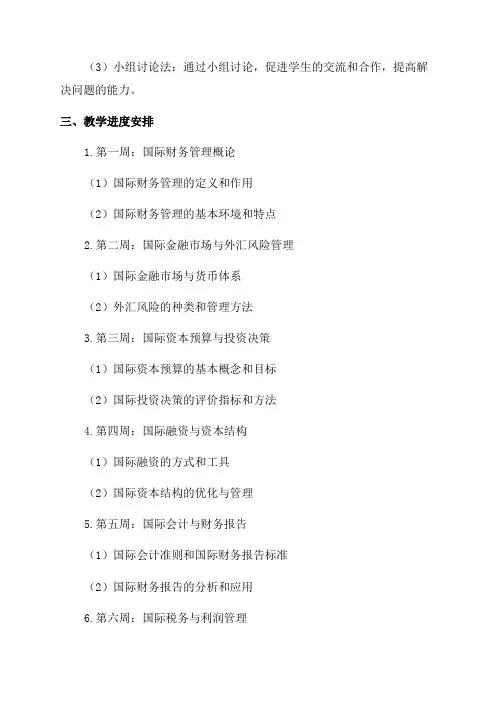
国际财务管理教案一、教学目标1.了解国际财务管理的基本概念、方法和相关理论。
2.理解并应用国际财务管理涉及的外汇风险管理、国际资本预算、国际融资等方面的知识和技能。
3.分析和解决国际财务管理中的实际问题。
4.培养学生的跨文化交际能力和团队合作意识。
二、教学内容与教学方法1.教学内容(1)国际财务管理的概念和作用(2)国际财务环境与风险管理(3)国际资本预算与投资决策(4)国际融资与资本结构(5)国际会计与财务报告(6)国际税务与利润管理2.教学方法(1)讲授法:通过课堂讲解,介绍国际财务管理的基本理论和概念。
(2)案例分析法:通过分析实际案例,引导学生运用国际财务管理的知识和技能解决实际问题。
(3)小组讨论法:通过小组讨论,促进学生的交流和合作,提高解决问题的能力。
三、教学进度安排1.第一周:国际财务管理概论(1)国际财务管理的定义和作用(2)国际财务管理的基本环境和特点2.第二周:国际金融市场与外汇风险管理(1)国际金融市场与货币体系(2)外汇风险的种类和管理方法3.第三周:国际资本预算与投资决策(1)国际资本预算的基本概念和目标(2)国际投资决策的评价指标和方法4.第四周:国际融资与资本结构(1)国际融资的方式和工具(2)国际资本结构的优化与管理5.第五周:国际会计与财务报告(1)国际会计准则和国际财务报告标准(2)国际财务报告的分析和应用6.第六周:国际税务与利润管理(1)国际税务规划与筹划(2)跨国企业利润管理与避税策略四、教学评估与考核方式1.平时考核(40%):包括课堂参与和小组讨论等学生表现。
2.期中考试(30%):以选择题和简答题形式考察学生对国际财务管理概念、模型和方法的理解与应用能力。
3.期末考试(30%):以论述题和应用题形式考察学生对国际财务管理实际问题的分析和解决能力。
五、教学资源准备。
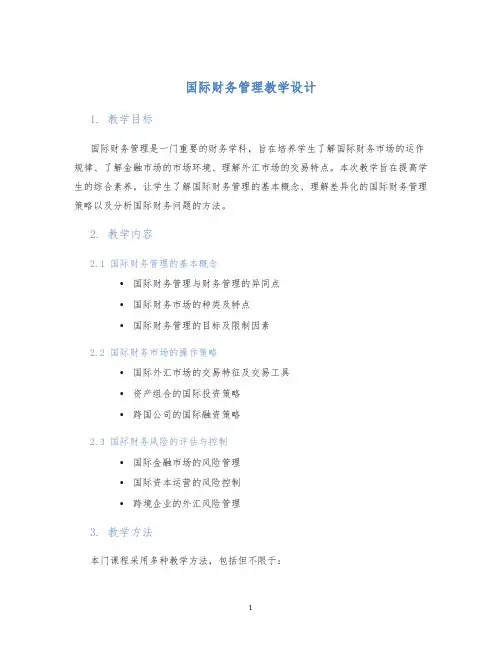
国际财务管理教学设计1. 教学目标国际财务管理是一门重要的财务学科,旨在培养学生了解国际财务市场的运作规律、了解金融市场的市场环境、理解外汇市场的交易特点。
本次教学旨在提高学生的综合素养,让学生了解国际财务管理的基本概念、理解差异化的国际财务管理策略以及分析国际财务问题的方法。
2. 教学内容2.1 国际财务管理的基本概念•国际财务管理与财务管理的异同点•国际财务市场的种类及特点•国际财务管理的目标及限制因素2.2 国际财务市场的操作策略•国际外汇市场的交易特征及交易工具•资产组合的国际投资策略•跨国公司的国际融资策略2.3 国际财务风险的评估与控制•国际金融市场的风险管理•国际资本运营的风险控制•跨境企业的外汇风险管理3. 教学方法本门课程采用多种教学方法,包括但不限于:•讲授法:通过讲解国际财务管理的基本概念、国际财务市场的交易特征等,让学生掌握相关知识;•实例分析:通过对具体的国际财务案例进行分析,让学生更好地理解理论知识;•讨论研究:通过小组讨论、班级辩论等方式,让学生扩展视野,深化对国际财务管理的认识。
4. 教学评估•平时表现:根据学生的课堂表现、小组讨论质量、作业完成情况等来评估学生的平时表现;•考试成绩:通过期末考试来评估学生对课程内容的掌握程度。
5. 课程参考书•Eiteman, D. K., Stonehill, A. I., & Moffett, M. H. (2016).Multinational business finance. Pearson.•Madura, J., & Fox, R. (2017). International Financial Management. Cengage Learning.•Shapiro, A. C. (2015). Multinational financial management.John Wiley & Sons.6. 教学资源•PowerPoint讲义:提供针对每一章内容的课件PPT,方便学生跟随上课;•实例分析资料:提供几个典型国际财务案例及相关资料,以供学生分析探讨;•作业模板:提供几道与课程内容相关的作业模板,帮助学生巩固所学知识。
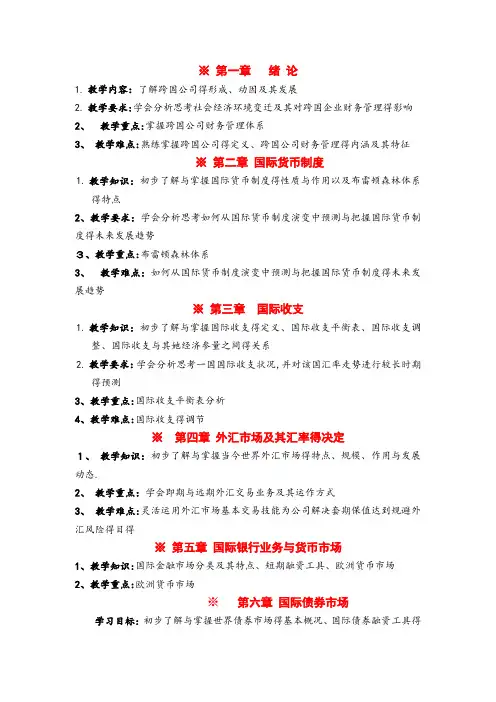
※第一章绪论1.教学内容:了解跨国公司得形成、动因及其发展2.教学要求:学会分析思考社会经济环境变迁及其对跨国企业财务管理得影响2、教学重点:掌握跨国公司财务管理体系3、教学难点:熟练掌握跨国公司得定义、跨国公司财务管理得内涵及其特征※第二章国际货币制度1.教学知识:初步了解与掌握国际货币制度得性质与作用以及布雷顿森林体系得特点2、教学要求:学会分析思考如何从国际货币制度演变中预测与把握国际货币制度得未来发展趋势3、教学重点:布雷顿森林体系3、教学难点:如何从国际货币制度演变中预测与把握国际货币制度得未来发展趋势※第三章国际收支1.教学知识:初步了解与掌握国际收支得定义、国际收支平衡表、国际收支调整、国际收支与其她经济参量之间得关系2.教学要求:学会分析思考一国国际收支状况,并对该国汇率走势进行较长时期得预测3、教学重点:国际收支平衡表分析4、教学难点:国际收支得调节※第四章外汇市场及其汇率得决定1、教学知识:初步了解与掌握当今世界外汇市场得特点、规模、作用与发展动态.2、教学重点:学会即期与远期外汇交易业务及其运作方式3、教学难点:灵活运用外汇市场基本交易技能为公司解决套期保值达到规避外汇风险得目得※第五章国际银行业务与货币市场1、教学知识:国际金融市场分类及其特点、短期融资工具、欧洲货币市场2、教学重点:欧洲货币市场※第六章国际债券市场学习目标:初步了解与掌握世界债券市场得基本概况、国际债券融资工具得具体操作,区别与比较本国债券、外国债券与欧洲债券之间得异同点,掌握国际债券市场得信用评级以及欧洲债券市场得结构与实务。
教学重点:区别与比较本国债券、外国债券与欧洲债券之间得异同点。
※第八章外汇期货与期权市场1、目标要求:初步了解与掌握外汇期货市场得基本特征;与远期外汇合约得异同;了解并熟悉外汇期权合约得各项技术及特性;学会利用外汇期货与期权市场进行合理避险.2、习题A、美国某出口商3月10号向加拿大出口一批货物,价值500000加元,以加元结算,3个月后收回货款.即期汇率为0、8490美元/加元.公司为避免3个月后加元汇率下跌得汇率风险应如何进行套期保值?解:根据外汇期货套期保值原理,该出口商为空头套期保值:(1)3个月后现汇汇率为:0、8460美元/加元期货市场盈利1950美元弥补现货市场损失1500美元之后,净盈利450美元(2)如果3个月后现汇汇率为:0、8500美元/加元现货市场盈利500美元抵补期货市场损失400美元之后,净盈利100美元B、美国某进口商2月10日从德国购进价值125000欧元得一批货,一个月后支付货款。
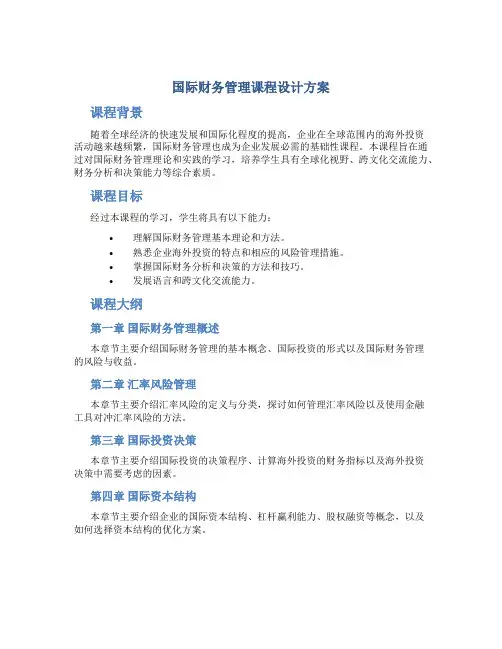
国际财务管理课程设计方案课程背景随着全球经济的快速发展和国际化程度的提高,企业在全球范围内的海外投资活动越来越频繁,国际财务管理也成为企业发展必需的基础性课程。
本课程旨在通过对国际财务管理理论和实践的学习,培养学生具有全球化视野、跨文化交流能力、财务分析和决策能力等综合素质。
课程目标经过本课程的学习,学生将具有以下能力:•理解国际财务管理基本理论和方法。
•熟悉企业海外投资的特点和相应的风险管理措施。
•掌握国际财务分析和决策的方法和技巧。
•发展语言和跨文化交流能力。
课程大纲第一章国际财务管理概述本章节主要介绍国际财务管理的基本概念、国际投资的形式以及国际财务管理的风险与收益。
第二章汇率风险管理本章节主要介绍汇率风险的定义与分类,探讨如何管理汇率风险以及使用金融工具对冲汇率风险的方法。
第三章国际投资决策本章节主要介绍国际投资的决策程序、计算海外投资的财务指标以及海外投资决策中需要考虑的因素。
第四章国际资本结构本章节主要介绍企业的国际资本结构、杠杆赢利能力、股权融资等概念,以及如何选择资本结构的优化方案。
第五章国际财务分析本章节主要介绍国际财务分析的方法,包括重要财务比率的计算和解读、国际财务报表分析、财务预测等技术。
第六章国际融资与财务市场本章节主要介绍国际上的融资环境和财务市场,包括国际融资的主要方式、投资组合的选择以及影响融资决策的因素。
课程教学方法本课程将采用多种教学方法,以提高学生的参与性和学习效果。
•讲授:教师将利用幻灯片等多媒体资料,对课程内容进行讲解。
•翻转课堂:教师将学习任务提前下发给学生,学生课前进行学习,教师课堂上与学生进行互动。
•课堂讨论:教师发起课堂话题,让学生进行讨论分析,并给予点评和意见反馈。
•课程作业:教师将针对课程内容布置作业,帮助学生巩固和加深对知识的理解,并培养自主学习能力。
课程评估本课程评估将分为课堂表现和考核。
•课堂表现:学生平时出勤情况、参与度和讨论表现。
•考核:期末考试占总评成绩的70%;课堂作业和小组演讲占30%。

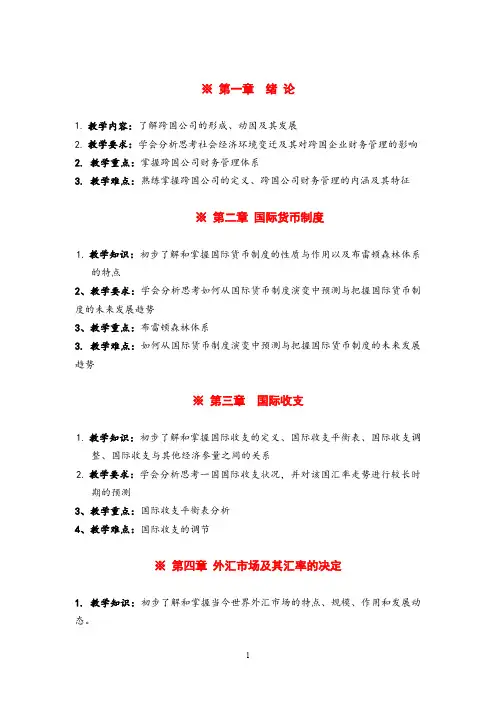
※第一章绪论1.教学内容:了解跨国公司的形成、动因及其发展2.教学要求:学会分析思考社会经济环境变迁及其对跨国企业财务管理的影响2. 教学重点:掌握跨国公司财务管理体系3. 教学难点:熟练掌握跨国公司的定义、跨国公司财务管理的内涵及其特征※第二章国际货币制度1.教学知识:初步了解和掌握国际货币制度的性质与作用以及布雷顿森林体系的特点2、教学要求:学会分析思考如何从国际货币制度演变中预测与把握国际货币制度的未来发展趋势3、教学重点:布雷顿森林体系3. 教学难点:如何从国际货币制度演变中预测与把握国际货币制度的未来发展趋势※第三章国际收支1.教学知识:初步了解和掌握国际收支的定义、国际收支平衡表、国际收支调整、国际收支与其他经济参量之间的关系2.教学要求:学会分析思考一国国际收支状况,并对该国汇率走势进行较长时期的预测3、教学重点:国际收支平衡表分析4、教学难点:国际收支的调节※第四章外汇市场及其汇率的决定1. 教学知识:初步了解和掌握当今世界外汇市场的特点、规模、作用和发展动态。
2. 教学重点:学会即期和远期外汇交易业务及其运作方式3. 教学难点:灵活运用外汇市场基本交易技能为公司解决套期保值达到规避外汇风险的目的※第五章国际银行业务与货币市场1、教学知识:国际金融市场分类及其特点、短期融资工具、欧洲货币市场2、教学重点:欧洲货币市场※第六章国际债券市场学习目标:初步了解和掌握世界债券市场的基本概况、国际债券融资工具的具体操作,区别和比较本国债券、外国债券和欧洲债券之间的异同点,掌握国际债券市场的信用评级以及欧洲债券市场的结构和实务。
教学重点:区别和比较本国债券、外国债券和欧洲债券之间的异同点。
※第八章外汇期货与期权市场1、目标要求:初步了解和掌握外汇期货市场的基本特征;与远期外汇合约的异同;了解并熟悉外汇期权合约的各项技术及特性;学会利用外汇期货与期权市场进行合理避险。
2、习题A、美国某出口商3月10号向加拿大出口一批货物,价值500000加元,以加元结算,3个月后收回货款。
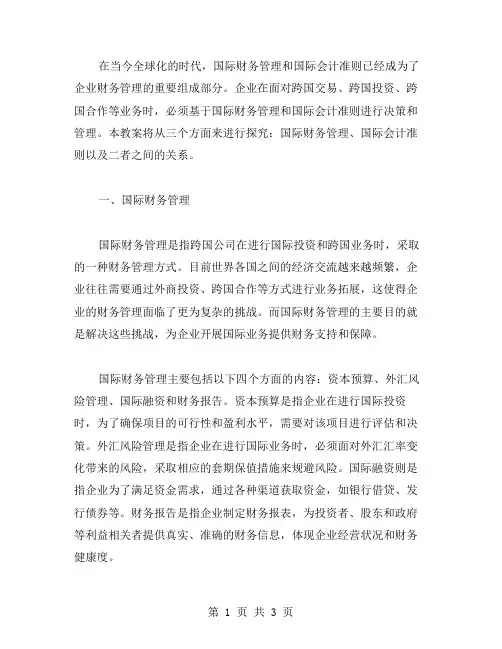
在当今全球化的时代,国际财务管理和国际会计准则已经成为了企业财务管理的重要组成部分。
企业在面对跨国交易、跨国投资、跨国合作等业务时,必须基于国际财务管理和国际会计准则进行决策和管理。
本教案将从三个方面来进行探究:国际财务管理、国际会计准则以及二者之间的关系。
一、国际财务管理国际财务管理是指跨国公司在进行国际投资和跨国业务时,采取的一种财务管理方式。
目前世界各国之间的经济交流越来越频繁,企业往往需要通过外商投资、跨国合作等方式进行业务拓展,这使得企业的财务管理面临了更为复杂的挑战。
而国际财务管理的主要目的就是解决这些挑战,为企业开展国际业务提供财务支持和保障。
国际财务管理主要包括以下四个方面的内容:资本预算、外汇风险管理、国际融资和财务报告。
资本预算是指企业在进行国际投资时,为了确保项目的可行性和盈利水平,需要对该项目进行评估和决策。
外汇风险管理是指企业在进行国际业务时,必须面对外汇汇率变化带来的风险,采取相应的套期保值措施来规避风险。
国际融资则是指企业为了满足资金需求,通过各种渠道获取资金,如银行借贷、发行债券等。
财务报告是指企业制定财务报表,为投资者、股东和政府等利益相关者提供真实、准确的财务信息,体现企业经营状况和财务健康度。
二、国际会计准则国际会计准则是指国际会计准则委员会(International Accounting Standards Board,简称IASB)制定的全球通用的会计准则,即国际财务报告准则(International Financial Reporting Standards,简称IFRS)。
IFRS是一套被广泛接受的会计准则,目前已被全球超过140个国家和地区采用。
IFRS与传统的会计准则相比,最大的优势在于它的全球通用性。
随着全球经济一体化进程的加快,会计准则的国际化已成为趋势。
使用IFRS可以使企业在全球化的经济环境下更有效地展开业务,减少各国不同会计准则带来的负面影响。
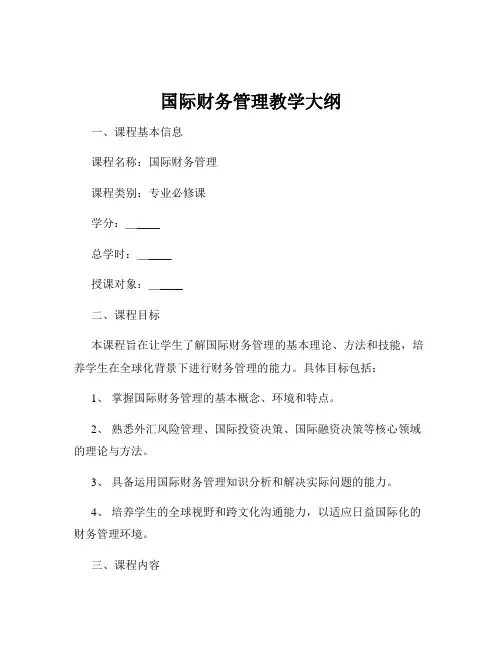
国际财务管理教学大纲一、课程基本信息课程名称:国际财务管理课程类别:专业必修课学分:_____总学时:_____授课对象:_____二、课程目标本课程旨在让学生了解国际财务管理的基本理论、方法和技能,培养学生在全球化背景下进行财务管理的能力。
具体目标包括:1、掌握国际财务管理的基本概念、环境和特点。
2、熟悉外汇风险管理、国际投资决策、国际融资决策等核心领域的理论与方法。
3、具备运用国际财务管理知识分析和解决实际问题的能力。
4、培养学生的全球视野和跨文化沟通能力,以适应日益国际化的财务管理环境。
三、课程内容(一)国际财务管理概述1、国际财务管理的定义、范围和重要性2、国际财务管理的环境因素,包括政治、经济、法律、文化等3、国际财务管理与国内财务管理的区别与联系(二)外汇市场与汇率1、外汇市场的运作机制2、汇率的决定因素和汇率制度3、汇率预测方法(三)外汇风险管理1、交易风险、折算风险和经济风险的识别与衡量2、外汇风险的防范策略,如套期保值、货币选择、提前或延迟收付等3、外汇风险管理的案例分析(四)国际投资决策1、国际直接投资和间接投资的特点与决策程序2、国际投资环境评估3、国际投资项目的现金流量分析和风险评估(五)国际融资决策1、国际融资渠道,如国际股权融资、国际债务融资、国际贸易融资等2、国际融资成本和资本结构的确定3、国际融资中的风险及其管理(六)国际营运资金管理1、国际现金管理、应收账款管理和存货管理2、国际转移定价的策略与运用(七)国际税收筹划1、国际税收体系和税收差异2、国际税收筹划的方法和策略3、避免国际双重征税的方法(八)跨国公司财务管理1、跨国公司的财务管理体制2、跨国公司内部资金转移和业绩评价3、跨国并购中的财务管理问题四、教学方法1、课堂讲授:讲解国际财务管理的基本理论和方法,引导学生建立系统的知识框架。
2、案例分析:通过实际案例分析,培养学生运用所学知识解决实际问题的能力。
3、小组讨论:组织学生进行小组讨论,促进学生之间的思想交流和团队合作能力。
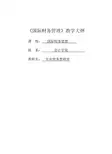
《国际财务管理》教学大纲课程:国际财务管理院系:会计学院教研室:专业财务教研室目录一、教学大纲编写说明 (2)二、课程课时分配表 (4)三、教学大纲目录 (5)四、教学大纲1.第一章国际财务管理导论 (7)2.第二章国际财务管理与文化、政治、法律环境 (10)3.第三章国际财务管理与经济环境 (13)4.第四章企业外汇风险管理 (17)5.第五章企业国际融资运作 (21)6.第六章企业国际投资分析 (24)7.第七章跨国经营的业绩评价与控制 (27)教学大纲编写说明一、本课程的性质随着我国加入WTO组织,经济开放的步伐加快,外国投资者加快了对中国的国际直接投资,中国企业也开始走出国门。
企业的国际业务数量增加,导致财务管理内容增加,国际财务管理已被提上议事日程。
该课程主要阐述企业跨出国界的特殊财务管理理论及技术,这一课程的研究和学习,必将提高我国企业财务管理工作的管理水平。
二、教学目的和要求国际财务管理课程的教学是针对财务管理专业的学生,使他们在不长的一段时期(一个学期)内,比较清楚地了解、理解和掌握国际财务的基本知识,这包括理论知识,还包括大部分具有可操作性的实务知识。
要求对这门课程的基本框架结构、基本概念、基本理论和基本操作程序必须掌握。
对难点问题反复思考和认真分析。
三、本课程教学内容安排本课程的内容分六个部分:第一部分为国际财务管理导论,主要介绍国际企业与经济全球化,国际财务管理的基本概念和特征。
第二部分为国际财务管理环境,介绍国际财务管理的文化、政治、法律、经济环境,重点介绍与国际财务关系较紧密的国际金融环境。
第三部分是企业外汇风险管理,包括外汇经营风险管理、外汇交易风险管理与外汇会计折算风险管理。
第四部分为国际融资运作,包括国际金融市场与国际融资、跨国公司资本成本与资本结构、国际营运资本管理。
第五部分为国际投资分析,包括国际投资组合、公司战略与国外直接投资、跨国公司资本预算,政治风险评价与管理。
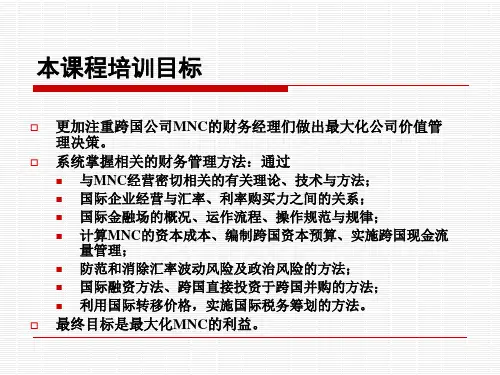
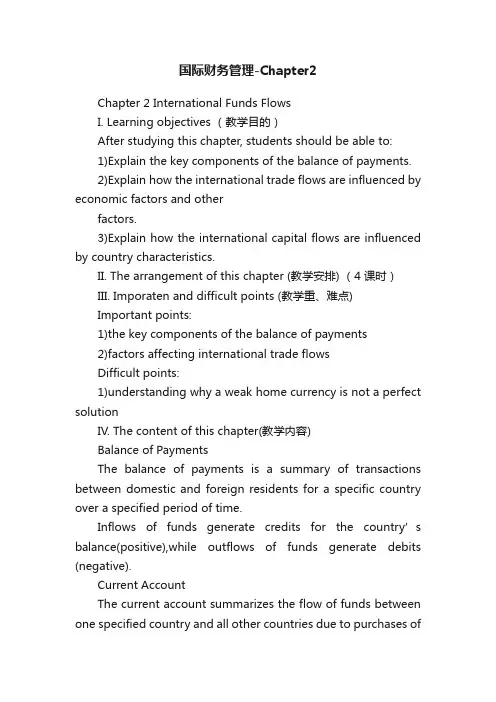
国际财务管理-Chapter2Chapter 2 International Funds FlowsI. Learning objectives (教学目的)After studying this chapter, students should be able to:1)Explain the key components of the balance of payments.2)Explain how the international trade flows are influenced by economic factors and otherfactors.3)Explain how the international capital flows are influenced by country characteristics.II. The arrangement of this chapter (教学安排) (4 课时)III. Imporaten and difficult points (教学重、难点)Important points:1)the key components of the balance of payments2)factors affecting international trade flowsDifficult points:1)understanding why a weak home currency is not a perfect solutionIV. The content of this chapter(教学内容)Balance of PaymentsThe balance of payments is a summary of transactions between domestic and foreign residents for a specific country over a specified period of time.Inflows of funds generate credits for the country’s balance(positive),while outflows of funds generate debits (negative).Current AccountThe current account summarizes the flow of funds between one specified country and all other countries due to purchases ofgoods or services, or the provision of income on financial assets.Key components of the current account include the balance of trade, factor income, and transfer payments.(介绍如下) Balance of trade is the difference between exports and imports.Factor income represents income (interest and dividend payments) received by investors on foreign investments in financial assets (securities).Transfer payments represent aid, grants, and gifts from one country to another.Capital AccountThe capital account summarizes the flow of funds resulting from the sale of assets between one specified country and all other countries.(反映国家对资产所有权的变动)The key components of the capital account are direct foreign investment, portfolio investment, and other capital investment.Direct foreign investment represents the investment in fixed assets in foreign countries that can be used to conduct business operations.Portfolio investment represents transactions involving long-term financial assets (such as stocks and bonds) between countries that do not affect the transfer of control.(主要包括国外金融资产如不含控制权的股票和债券的买卖)Other capital investment represents transactions involving short-term financial assets(such as money market securities) between countries.(包括货币交易、银行存款、贸易信贷等)International Trade FlowsSome countries are more dependent on trade than others:The trade volume of a European country is typically between 30 –40% of its GDP, while the trade volume of U.S. (and Japan) istypically between 10 –20% of its GDP.The Distribution of U.S. Exports across Countries, Distribution of U.S. Exports and Imports and U.S. Balance of Trade Over Time on transparency 7-9.Factors Affecting International Trade Flows1. Impact of Inflation: A relative increase in a country’s inflation rate will decrease its current account, as imports increase and exports decrease.2. Impact of National Income: A relative increase in a country’s income level will decrease its current account, as imports increase.3. Impact of Government Restrictions: A government may reduce its country’s imports by imposing a tariff on imported goods, or by enforcing a quota. Some trade restrictions may be imposed on certain products for health and safety reasons. (Example on page 43)4.Impact of Exchange Rates: If a country’s currency begins to rise in value, its current account balance will decrease as imports increase and exports decrease.In a word, the factors interact, such that their simultaneous influence on the balance of trade is complex.Why a Weak Home Currency Is Not a Perfect Solution1. Counterpricing by competitors2. Impact of other weak currencies (Example on page 45)3. Stability of intracompany trade: Many firms purchase products that are produced by theirsubsidiaries.4. Prearranged international transactions: The lag time between a weaker U.S.$ and increased foreign demand has been estimated to be 18 months or longer. (J-Curve Effect ontransparency 17)Agencies that Facilitate International Flows1. International Monetary Fund (IMF)The IMF encourages internationalization of businesses through surveillance, and financial and technical assistance.Its compensatory financing facility attempts to reduce the impact of export instability on country economies.The IM F adopts a quota system, and its financing is measured in special drawing rights (SDRs)2. World BankThis International Bank for Reconstruction and Development makes loans to countries to enhance their economic development.In particular, its Structural Adjustment Loans (SALs) are intended to enhance a country’s long-term economic growth.Funds are spread through cofinancing agreements with official aid agencies, export credit agencies, and commercial banks.3. International Development AssociationThe IDA extends loans at low interest rates to poor nations that cannot qualify for loans from the World Bank.4. World Trade OrganizationThe WTO was established to provide a forum for multilateral trade negotiations and to settle trade disputes related to the GA TT accord.5. International Financial CorporationThe IFC promotes private enterprise within countries through loan provisions and stock purchases.6. Bank for International SettlementsThe BIS is the “central banks’central bank”and “lender oflast resort.”7. Regional development agenciesInter-American Development BankAsian Development BankAfrican Development BankEuropean Bank for Reconstruction and Development。
《国际财务管理(双语)》课程教案主讲人:熊家财江西财经大学会计学院二0一五年四月教案编写说明1.本教案根据2014-2015学年2学期国际财务管理选用教材、教学大纲和教学进度表编写。
所依据的教材及参考书目如下:教材:Geert Bekaert, Robert J. Hodrick:《International Financial Management》,东北财经大学出版社。
参考书目:[1]《跨国公司财务管理》,毛付根、林涛,东北财经大学出版社,2010;[2]《国际财务管理》,崔学刚,机械工业出版社,2009;[3]《国际金融(第二版)》,吕江林,科学出版社,2010;[4]《期货、期权及其他衍生品》,John Hull, 机械工业出版社,2011。
2.本教案所涉及的详细案例资料和补充阅读材料不在教案中列示,存放在BB网络教学平台中。
3.本教案的编写在课程进行之前,在课程讲授过程中会根据学生的接受程度和教学效果反馈情况进行相应地调整。
4.由于教案只是供教师使用,因此,只列示了关键内容,而没有将授课中所有内容进行详细列示。
教学手段和方法一、教学手段多媒体课件、BB教学平台、网络工具二、教学方法1.课堂讲授对于国际财务管理中涉及的基本概念、风险管理和套期保值内容,由老师在课堂中进行讲解,帮助学生尽快掌握和理解相关基础内容。
并在讲解过程采用提问和启发等教学手段,着力提高学生独立分析和思考问题的能力。
2.讨论本课程教学中的讨论分为两种:一种在课堂时间进行,一种通过毕博平台的讨论板在课后进行。
讨论的问题题材广泛,与课程相关,但不局限于课本内容。
3.案例分析在课程进行到后期阶段,将安排一次综合案例分析,由学生自由组队,每队完成一份案例分析报告,并选一位代表在课堂上做讲解演示。
第一讲全球化与跨国公司一、教学目的和要求的明确与实施[教学目的与要求]通过本章的学习,要求学生掌握以下基本知识点:(一)掌握全球化的含义(二)掌握全球化的产生背景、表现形式(三)掌握跨国公司的含义,掌握跨国公司经营特点、财务管理的特点、内容(四)了解其他重要的国际参与者(五)了解全球化的正、负面影响(六)掌握国际财务管理概念体系和逻辑框架。
Chapter 3 International Financial MarketsI. Learning objectives (教学目的)After studying this chapter, students should be able to describe the background and corporate use of the following international financial markets:1)foreign exchange market,2)international money market,3)international credit market,4)international bond market, and5)international stock marketsII.The arrangement of this chapter (教学安排) (3 课时)III.Important and difficult points (教学重、难点)Important points:1)foreign exchange marketDifficult points:1)cross exchange rate2)interpreting foreign exchange quotationsIV. The content of this chapter(教学内容)Motives for Using International Financial Markets1. Investors invest in foreign markets:Economic condition: to take advantage of favorable economic conditions;Exchange rate expectations: when they expect foreign currencies to appreciate against their own;International diversification: to reap the benefits of international diversification2.Creditors provide credit in foreign markets:High foreign interest rates: to capitalize on higher foreign interest rates;Exchange rate expectations: when they expect foreign currencies to appreciate against their own; International diversification: to reap the benefits of diversification.3.Borrowers borrow in foreign markets:Low interest rates: to capitalize on lower foreign interest rates; and exchange rate expectations: when they expect foreign currencies to depreciate against their own.Foreign Exchange MarketThe foreign exchange market allows currencies to be exchanged in order to facilitate international trade or financial transactions.The system for exchanging foreign currencies has evolved from the gold standard, to agreements on fixed exchange rates, to a floating rate system.Foreign Exchange Transactions (spot market and forward market)The market for immediate exchange is known as the spot market.The forward market enables an MNC to lock in the exchange rate at which it will buy or sell a certain quantity of currency on a specified future date.Bid/Ask Spread of BanksA bank’s bid (buy) quote for a foreign currency will be less than its ask (sell) quote.bid/ask spread = (ask rate –bid rate)÷ask rateExample: Suppose bid price for £ = $1.52, ask price = $1.60.Spread = (1.60 –1.52) ÷1.60= .05 or 5%Interpreting Foreign Exchange QuotationsThe exchange rate quotations published in newspapers normally reflect the ask prices for large transactions.1) Direct quotations represent the value of a foreign currency in dollars, while indirect quotations represent the number of units of a foreign currency per dollar.Indirect quotation = 1/Direct quotation2) A cross exchange rate reflects the amount of one foreign currency per unit of another foreign currency.Example: Direct quote: $1.50/£, $.125/¥Value of £ in ¥ = value of £ in $÷value of ¥ in $ = $1.50/£÷$.125/¥ = 12¥/£International Money Market1) The Eurocurrency market (market for Eurodollars) developed during the 1960s and 1970s, and the growing importance of OPEC.2) The growing standardization of global banking regulations has contributed towards the globalization of the industry.The Single European Act opened up the European banking industry and increased its efficiency.The Basel Accord results in a higher required capital ration for riskier assets.The proposed Basel II Accord attempts to account for operational risk.International Credit MarketEurocredit loans refer to loans of one year or longer extended by banks in Europe to foreign MNCs or government agencies.Floating rate loans, such as London Inter-bank Offer RateSyndicated LoansInternational Bond Market1) There are two types of international bonds:❶Bonds denominated in the currency of the country where they are placed but issued by borrowers foreign to the country are called foreign bonds or parallel bonds.❷Bonds that are sold in countries other than the country of the currency denominating the bonds are called Eurobonds.2) The emergence of the Eurobond market was partly due to the 1963 U.S. Interest Equalization Tax (IET). It discourages U.S. investors from investing in foreign securities.3) Features of Eurobonds: Eurobonds are issued in bearer form, pay annual coupons. Some also carry convertibility clauses, or have variable rate.International Stock MarketsStock issued in the U.S. by non-U.S. firms or governments are called Yankee stock offerings.Many of such recent stock offerings resulted from privatization programs in Latin America and Europe.Non-U.S. firms may also issue American depository receipts (ADRs), which are certificates representing bundles of stock.Comparison of International Financial MarketsThe foreign cash flow movements of a typical MNC can be classified into: ★Foreign trade –exports and imports★Direct foreign investment (DFI) –acquisition of foreign real assets★Short-term investment or financing in foreign securities★Longer-term financing in the international bond or stock markets。